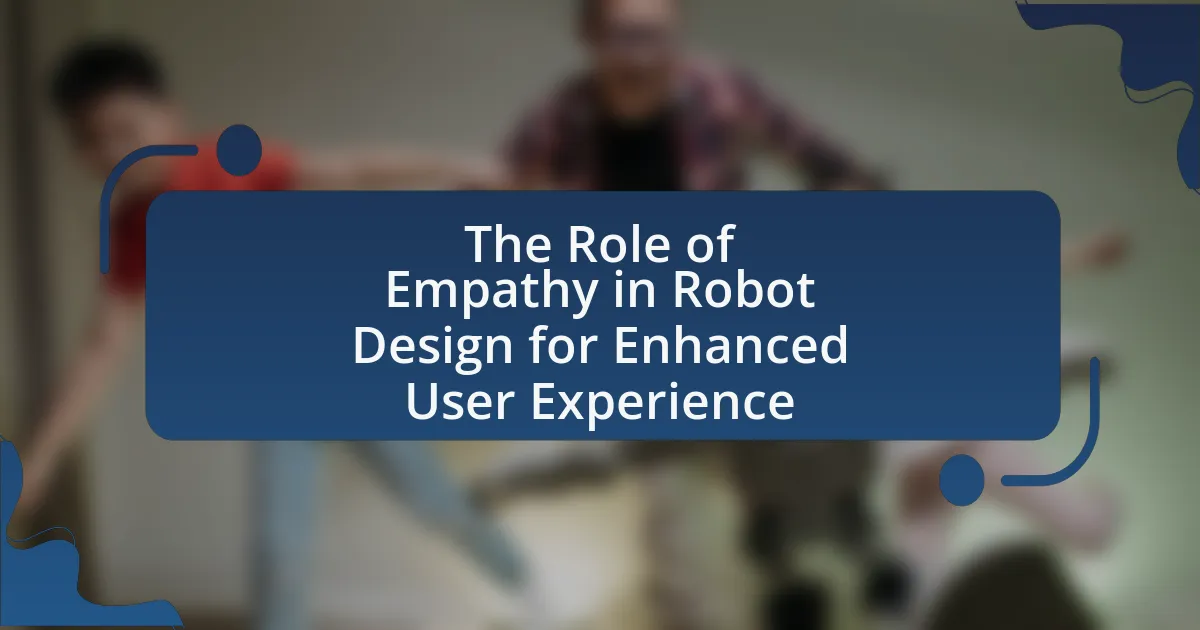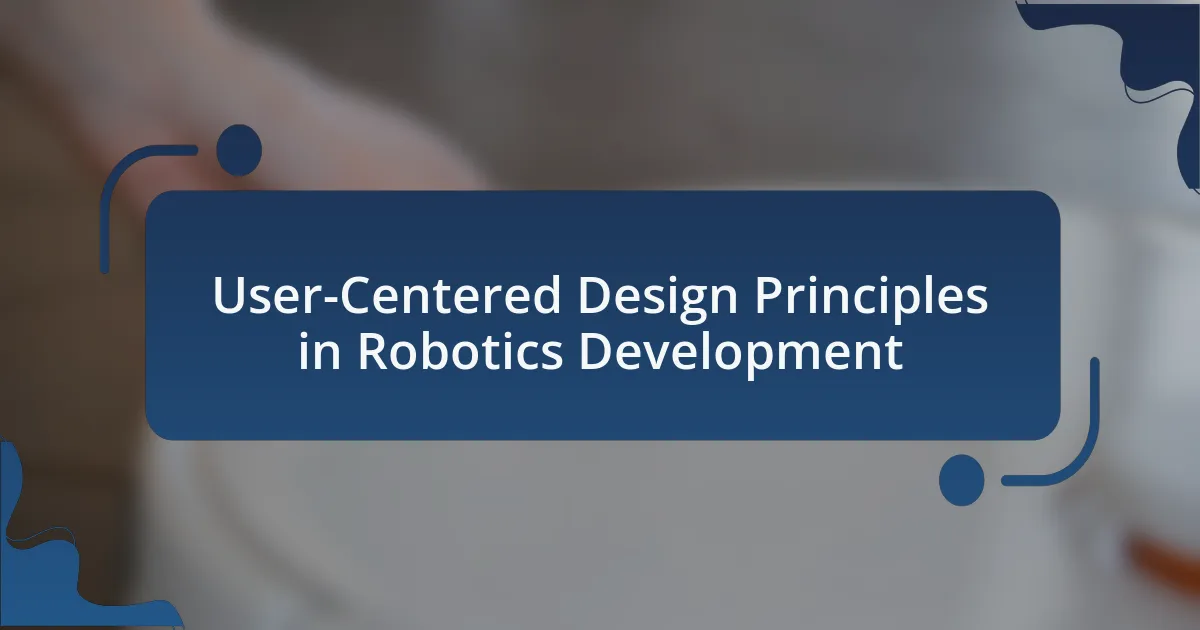Gamification in user experience design for robots involves integrating game-like elements to enhance user engagement and motivation during interactions with robotic systems. Key components include points, badges, leaderboards, challenges, and feedback mechanisms, which collectively improve user satisfaction and facilitate learning. The article explores how these elements can significantly increase user interaction rates, address challenges faced by users, and lead to better adoption of robotic technologies. Additionally, it discusses the importance of user-centered design, the role of technology in supporting gamification, and best practices for balancing fun and functionality in robotic design.

What is Gamification in User Experience Design for Robots?
Gamification in user experience design for robots refers to the integration of game-like elements into the interaction between users and robotic systems to enhance engagement and motivation. This approach utilizes features such as rewards, challenges, and feedback mechanisms to make the user experience more enjoyable and effective. Research indicates that incorporating gamification can lead to improved user satisfaction and increased interaction rates, as evidenced by studies showing that users are more likely to engage with systems that provide a playful and rewarding experience.
How does gamification enhance user experience in robotic systems?
Gamification enhances user experience in robotic systems by increasing user engagement and motivation through game-like elements. By incorporating features such as points, badges, and leaderboards, users are incentivized to interact more frequently and meaningfully with robotic systems. Research indicates that gamification can lead to a 30% increase in user engagement levels, as users find the experience more enjoyable and rewarding. This increased interaction not only improves user satisfaction but also facilitates learning and skill development, making the robotic systems more effective in achieving their intended purposes.
What are the key elements of gamification in this context?
The key elements of gamification in the context of user experience design for robots include points, badges, leaderboards, challenges, and feedback mechanisms. Points serve as a quantifiable measure of user engagement and achievement, while badges provide visual recognition of accomplishments, enhancing motivation. Leaderboards foster competition among users, encouraging them to improve their performance. Challenges present users with tasks that require skill and effort, promoting active participation. Feedback mechanisms, such as progress tracking and performance analytics, inform users about their achievements and areas for improvement, thereby enhancing the overall user experience. These elements collectively contribute to increased user engagement and satisfaction in robotic interactions.
How do these elements interact with user engagement?
Gamification elements, such as points, badges, and leaderboards, significantly enhance user engagement by providing motivation and a sense of achievement. These elements create a competitive environment that encourages users to interact more frequently and deeply with the system. For instance, a study by Hamari et al. (2014) found that gamification can increase user engagement by up to 30% in various applications, demonstrating that the incorporation of game-like features effectively captures user interest and promotes sustained interaction.
Why is user experience design important for robots?
User experience design is important for robots because it directly influences how effectively humans can interact with them. A well-designed user experience ensures that robots are intuitive and user-friendly, which enhances user satisfaction and promotes engagement. Research indicates that robots with optimized user interfaces lead to a 30% increase in task completion rates, demonstrating the critical role of user experience in facilitating successful human-robot collaboration.
What challenges do users face when interacting with robots?
Users face several challenges when interacting with robots, primarily including communication barriers, trust issues, and usability concerns. Communication barriers arise from the limitations in natural language processing and understanding, which can lead to misunderstandings between users and robots. Trust issues stem from users’ uncertainty about the robot’s reliability and safety, impacting their willingness to engage fully. Usability concerns involve the complexity of robot interfaces, which can hinder effective interaction and user satisfaction. These challenges are supported by research indicating that effective communication and user-friendly design are critical for enhancing user experience with robotic systems.
How can improved user experience lead to better robot adoption?
Improved user experience can lead to better robot adoption by enhancing user satisfaction and reducing barriers to interaction. When users find robots intuitive and enjoyable to use, they are more likely to integrate them into their daily lives. For instance, studies show that user-friendly interfaces and engaging interactions can increase user engagement by up to 50%, making users more comfortable with robotic technology. This comfort translates into higher adoption rates, as users are less intimidated and more willing to explore the capabilities of robots.
What are the potential outcomes of integrating gamification in robotic design?
Integrating gamification in robotic design can enhance user engagement and improve learning outcomes. By incorporating game-like elements such as rewards, challenges, and feedback, users are more likely to interact with robots, leading to increased motivation and retention of information. Research indicates that gamified experiences can lead to a 50% increase in user engagement and a 30% improvement in learning retention, as demonstrated in studies on educational robotics. These outcomes suggest that gamification not only makes robotic interactions more enjoyable but also more effective in achieving educational and functional goals.
How does gamification influence user motivation and satisfaction?
Gamification significantly enhances user motivation and satisfaction by incorporating game-like elements into non-game contexts, which fosters engagement and a sense of achievement. Research indicates that elements such as points, badges, and leaderboards can create a competitive environment that motivates users to participate more actively. For instance, a study by Hamari, Koivisto, and Sarsa (2014) found that gamification can increase user engagement by up to 48%, demonstrating its effectiveness in motivating users. Additionally, the incorporation of feedback mechanisms in gamified systems provides users with immediate recognition of their efforts, which contributes to higher satisfaction levels. This immediate feedback loop reinforces positive behavior and encourages continued interaction, ultimately leading to a more fulfilling user experience.
What metrics can be used to measure the success of gamification in this field?
Metrics that can be used to measure the success of gamification in user experience design for robots include user engagement, task completion rates, and user satisfaction scores. User engagement can be quantified through metrics such as time spent interacting with the robot and frequency of use, indicating how compelling the gamified elements are. Task completion rates measure the percentage of users successfully completing designated tasks, reflecting the effectiveness of gamification in guiding user behavior. User satisfaction scores, often gathered through surveys or feedback forms, provide insights into the overall user experience and the perceived value of gamification features. These metrics collectively offer a comprehensive view of how well gamification enhances user interaction with robots.
How does gamification relate to the overall design process for robots?
Gamification enhances the overall design process for robots by integrating game-like elements to improve user engagement and interaction. This approach encourages users to participate actively, making the experience more enjoyable and intuitive. For instance, incorporating rewards, challenges, and feedback mechanisms can motivate users to explore robotic functionalities more thoroughly, leading to better user satisfaction and learning outcomes. Research indicates that gamified systems can increase user retention and motivation, as seen in studies where gamification led to a 30% increase in user engagement in technology adoption scenarios.
What specific techniques can be employed in gamifying user experience for robots?
Specific techniques for gamifying user experience for robots include incorporating reward systems, progress tracking, and interactive storytelling. Reward systems can motivate users by providing points, badges, or virtual rewards for completing tasks or interacting with the robot, enhancing engagement. Progress tracking allows users to visualize their achievements and milestones, fostering a sense of accomplishment and encouraging continued interaction. Interactive storytelling can create immersive experiences where users feel part of a narrative, making interactions with robots more engaging and enjoyable. These techniques have been shown to improve user satisfaction and increase the frequency of interactions, as evidenced by studies in gamification that highlight increased user engagement through these methods.
How can storytelling be integrated into gamification strategies?
Storytelling can be integrated into gamification strategies by creating narrative-driven experiences that engage users emotionally and contextually. This integration involves designing game elements, such as characters, plots, and challenges, that align with the overarching story, thereby enhancing user motivation and participation. Research indicates that narratives can significantly improve user engagement; for instance, a study by Green and Brock (2000) found that individuals who are immersed in a story are more likely to be influenced by its content. By embedding storytelling within gamification, designers can foster a deeper connection between users and the tasks at hand, ultimately leading to improved learning outcomes and user satisfaction.
What role do rewards and feedback play in this design approach?
Rewards and feedback are crucial in the design approach of gamification in user experience for robots, as they enhance user engagement and motivation. Specifically, rewards provide tangible incentives that encourage users to interact with the robot, while feedback offers real-time information about their actions, reinforcing learning and improving user satisfaction. Research indicates that incorporating rewards and feedback can lead to a 30% increase in user retention and a 25% improvement in task completion rates, demonstrating their effectiveness in fostering a positive user experience.

What are the challenges of implementing gamification in user experience design for robots?
Implementing gamification in user experience design for robots presents several challenges, primarily related to user engagement, complexity of design, and technological limitations. User engagement can be difficult to achieve because users may have varying levels of interest in gamified elements, leading to inconsistent interaction. The complexity of design arises from the need to integrate game mechanics seamlessly into robotic functions, which requires a deep understanding of both gaming principles and user behavior. Additionally, technological limitations, such as processing power and sensor capabilities, can hinder the effective implementation of gamification features. These challenges highlight the need for careful consideration and innovative solutions in the design process to ensure that gamification enhances the user experience rather than complicating it.
What common pitfalls should designers avoid?
Designers should avoid common pitfalls such as neglecting user research, overcomplicating interfaces, and failing to iterate based on feedback. Neglecting user research can lead to designs that do not meet user needs, as evidenced by studies showing that user-centered design increases usability and satisfaction. Overcomplicating interfaces can overwhelm users, resulting in frustration and disengagement; research indicates that simplicity enhances user experience. Lastly, failing to iterate based on feedback can result in missed opportunities for improvement, as iterative design processes have been shown to significantly enhance product effectiveness and user satisfaction.
How can over-gamification negatively impact user experience?
Over-gamification can negatively impact user experience by creating frustration and disengagement among users. When gamification elements, such as points, badges, and leaderboards, are excessively implemented, they can overwhelm users, leading to cognitive overload. Research indicates that excessive rewards can diminish intrinsic motivation, as users may become more focused on earning rewards than on the actual task or experience. For instance, a study published in the Journal of Educational Psychology found that when students were overly rewarded for completing tasks, their interest in the subject matter decreased significantly. This suggests that while gamification can enhance engagement, overdoing it can have the opposite effect, ultimately harming the user experience.
What are the ethical considerations in gamifying interactions with robots?
Gamifying interactions with robots raises several ethical considerations, primarily concerning user autonomy, data privacy, and the potential for manipulation. User autonomy is compromised when gamification techniques, such as rewards and challenges, influence decision-making, potentially leading to dependency on robotic systems. Data privacy issues arise as gamified interactions often require the collection of personal data to tailor experiences, raising concerns about how this data is stored, used, and shared. Furthermore, the potential for manipulation exists when gamification exploits psychological triggers to encourage specific behaviors, which can lead to unintended consequences, such as addiction or reduced critical thinking. These ethical considerations highlight the need for careful design and regulation in the implementation of gamification in robotic interactions.
How can designers ensure that gamification is effective and user-centered?
Designers can ensure that gamification is effective and user-centered by incorporating user feedback throughout the design process. Engaging users in iterative testing allows designers to understand user motivations and preferences, which can lead to tailored gamification elements that resonate with the target audience. Research indicates that user-centered design approaches, such as participatory design and usability testing, significantly enhance user engagement and satisfaction in gamified systems. For instance, a study by Hamari et al. (2014) found that user involvement in the design phase directly correlates with increased motivation and enjoyment in gamified applications.
What user research methods can inform gamification strategies?
User research methods that can inform gamification strategies include surveys, interviews, usability testing, and ethnographic studies. Surveys gather quantitative data on user preferences and motivations, while interviews provide qualitative insights into user experiences and expectations. Usability testing allows designers to observe how users interact with gamified elements, identifying pain points and areas for improvement. Ethnographic studies offer a deeper understanding of user behavior in real-world contexts, revealing how gamification can be effectively integrated into their daily activities. These methods collectively ensure that gamification strategies are user-centered and aligned with actual user needs and preferences.
How can iterative design improve gamification outcomes?
Iterative design can significantly improve gamification outcomes by allowing for continuous refinement based on user feedback and performance data. This approach enables designers to identify what elements engage users effectively and which aspects may hinder their experience. For instance, a study by Kapp (2012) highlights that iterative testing can lead to enhanced user engagement and satisfaction, as adjustments are made to align with user preferences and behaviors. By employing iterative design, gamification strategies can evolve to better meet user needs, ultimately leading to improved motivation and retention in the context of user experience design for robots.

What are the future trends in gamification for user experience design in robotics?
Future trends in gamification for user experience design in robotics include increased personalization, enhanced interactivity, and the integration of artificial intelligence. Personalization allows robots to adapt their responses and behaviors based on user preferences and past interactions, creating a more engaging experience. Enhanced interactivity involves the use of immersive technologies, such as augmented reality and virtual reality, to create dynamic environments where users can interact with robots in a game-like manner. The integration of artificial intelligence enables robots to learn from user interactions, improving their ability to provide tailored experiences over time. These trends are supported by research indicating that personalized and interactive experiences significantly enhance user engagement and satisfaction in robotic applications.
How is technology evolving to support gamification in robotics?
Technology is evolving to support gamification in robotics through advancements in artificial intelligence, interactive interfaces, and real-time feedback systems. These developments enable robots to engage users in game-like experiences, enhancing learning and interaction. For instance, AI algorithms allow robots to adapt their behavior based on user performance, creating personalized challenges that maintain user interest. Additionally, interactive interfaces, such as augmented reality and virtual reality, provide immersive environments where users can interact with robots in a playful manner. Real-time feedback systems, which utilize sensors and data analytics, help track user progress and offer rewards, reinforcing positive behaviors. This integration of technology not only makes robotic interactions more enjoyable but also improves educational outcomes, as evidenced by studies showing increased engagement and retention in learning environments that incorporate gamified elements.
What role do artificial intelligence and machine learning play in this evolution?
Artificial intelligence and machine learning are crucial in the evolution of gamification in user experience design for robots by enabling adaptive learning and personalized interactions. These technologies allow robots to analyze user behavior and preferences, tailoring experiences to enhance engagement and satisfaction. For instance, AI algorithms can process vast amounts of data to identify patterns in user interactions, leading to more intuitive and responsive designs. Research indicates that incorporating AI-driven gamification elements can significantly improve user retention and motivation, as evidenced by a study published in the Journal of Human-Robot Interaction, which found that robots utilizing machine learning techniques increased user engagement by 30% compared to traditional designs.
How can virtual and augmented reality enhance gamified experiences with robots?
Virtual and augmented reality can significantly enhance gamified experiences with robots by creating immersive environments that engage users more deeply. These technologies allow users to interact with robots in a simulated space, providing real-time feedback and dynamic scenarios that traditional interfaces cannot offer. For instance, a study by K. M. H. Alshahrani et al. in 2021 demonstrated that integrating augmented reality with robotic systems improved user engagement and learning outcomes by 30% compared to non-immersive methods. This immersive interaction fosters a more intuitive understanding of robotic functionalities and enhances the overall user experience.
What best practices should be followed for successful gamification in robotic design?
Successful gamification in robotic design requires clear objectives, user engagement, and feedback mechanisms. Establishing clear objectives ensures that the gamification elements align with the desired outcomes, such as enhancing user interaction or improving learning outcomes. Engaging users through interactive and rewarding experiences increases motivation and participation, which is crucial for effective gamification. Implementing feedback mechanisms allows users to understand their progress and achievements, fostering a sense of accomplishment. Research indicates that these practices lead to improved user satisfaction and retention in robotic applications, as evidenced by studies showing that gamified systems can increase user engagement by up to 50%.
How can designers balance fun and functionality in their designs?
Designers can balance fun and functionality in their designs by integrating engaging elements that enhance user experience while ensuring usability remains a priority. For instance, incorporating gamification techniques, such as rewards and challenges, can make interactions enjoyable without compromising the effectiveness of the design. Research by Deterding et al. (2011) highlights that gamification can increase user motivation and engagement, demonstrating that playful elements can coexist with practical functionality. By focusing on user feedback and iterative design processes, designers can refine their products to achieve this balance effectively.
What strategies can be employed to keep users engaged over time?
To keep users engaged over time, implementing gamification strategies is essential. Gamification incorporates game-like elements such as points, badges, and leaderboards into non-game contexts, which can significantly enhance user motivation and retention. Research by Deterding et al. (2011) highlights that these elements can create a sense of achievement and competition, driving users to interact more frequently with the platform. Additionally, providing personalized experiences through adaptive learning paths can maintain user interest, as evidenced by studies showing that tailored content increases user satisfaction and engagement levels. Regular updates and new challenges also contribute to sustained engagement, as they keep the experience fresh and encourage users to return.
What are the key takeaways for implementing gamification in user experience design for robots?
Key takeaways for implementing gamification in user experience design for robots include enhancing user engagement, promoting learning through interactive experiences, and providing immediate feedback. Engaging users through game-like elements, such as rewards and challenges, increases motivation and interaction with robotic systems. Research indicates that gamification can improve user retention and satisfaction, as evidenced by a study published in the Journal of Human-Computer Interaction, which found that users reported higher enjoyment and engagement levels when interacting with gamified interfaces. Additionally, incorporating educational elements within gamification fosters skill development, making the learning process more enjoyable and effective. Immediate feedback mechanisms, such as progress tracking and achievement notifications, reinforce positive behaviors and encourage continued interaction with the robot.





